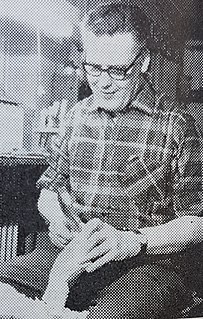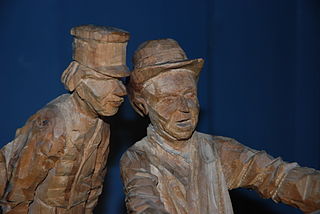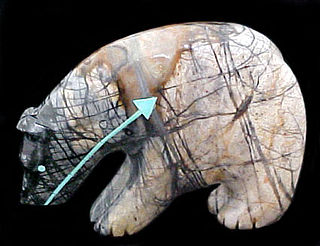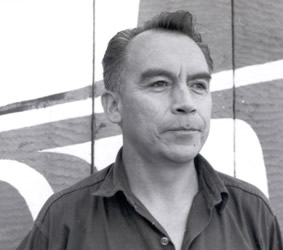Harold Enlow began woodcarving in the 1960s while stationed in Okinawa, Japan. He has become one of America's leading wood carvers.[ according to whom? ] He is a member of Caricature Carvers of America.

Totem poles are monumental carvings, a type of Northwest Coast art, consisting of poles, posts or pillars, carved with symbols or figures. They are usually made from large trees, mostly western red cedar, by First Nations and Indigenous peoples of the Pacific Northwest Coast including northern Northwest Coast Haida, Tlingit, and Tsimshian communities in Southeast Alaska and British Columbia, Kwakwaka'wakw and Nuu-chah-nulth communities in southern British Columbia, and the Coast Salish communities in Washington and British Columbia.

Wood carving is a form of woodworking by means of a cutting tool (knife) in one hand or a chisel by two hands or with one hand on a chisel and one hand on a mallet, resulting in a wooden figure or figurine, or in the sculptural ornamentation of a wooden object. The phrase may also refer to the finished product, from individual sculptures to hand-worked mouldings composing part of a tracery.

Alebrijes are brightly colored Mexican folk art sculptures of fantastical (fantasy/mythical) creatures. The first alebrijes, along with the invention of the term, originated with Mexico City cartonero Pedro Linares. Linares often told that in 1943, he fell very ill, and while he was in bed unconscious, he dreamt of a strange place resembling a forest. There, he saw trees, rocks, clouds that suddenly turned into something strange, and some kind of animals but unknown animals. He saw "a donkey with butterfly wings, a rooster with bull horns, and a lion with an eagle head", and all of them were shouting one word, "Alebrijes! Alebrijes! Alebrijes!" Before this happened, he was already a cartonero artisan. Upon recovery, he began recreating the creatures he had seen in cartonería, the making of three-dimensional sculptures with different types of papers, strips of papers and engrudo.
Carl Johan Trygg, formally Carl Johan Thrygg, also knowns as C. J. Trygg, woodcarver, was one of the recognized masters of twentieth century woodcarving, most famous for Scandinavian flat-plane style of woodcarving. Between C. J. Trygg and his sons they carved over 10,000 figures. Many of his carvings were sold to tourists for approximately $10.00 USD. Adjusted for inflation what cost $10.00 in 1929 would cost $108.05 in 2005.

Carl Olof Trygg, was one of the recognized masters of 20th century woodcarving, most famous for Scandinavian flat-plane style of woodcarving.

Axel Petersson Döderhultarn, formerly Axel Petersson, was a Swedish wood carver who was one of the recognized masters of wood carving, most famous for Scandinavian flat-plane style of woodcarving.
In 1989, a group of ten wood carvers, with the common goal of promoting the art of caricature carving, met in the back room of Paxton Lumber Co. in Fort Worth, Texas to discuss the formation of a national organization to further that goal. From that meeting came the Caricature Carvers of America (CCA). The founding group consisted of fifteen nationally recognized wood carvers representing a broad geographical distribution as well as diverse styles of caricature carving. Since the inception of the CCA, two members have resigned, four have converted their membership to "emeritus" status, three are deceased, and eighteen new members have been elected, bringing the 2003 membership to 25. The newly formed organization made no claims of being "the best," although many of the members are readily recognized as being among the elite in the carving community. The combined membership has garnered several hundred first place ribbons, including many "Best-of-Show", in carving competitions across the nation; they have published over 80 books on wood carving; and they regularly teach wood carving seminars throughout the United States and Canada.
Lars Trygg, woodcarver, was one of the recognized masters of 20th century wood carving, most famous for Scandinavian flat-plane style of woodcarving.

Herbert S. Anderson, known commonly as H. S. "Andy" Anderson, was an American woodcarver, one of the recognized masters of 20th-century woodcarving, most famous for Scandinavian flat-plane style of woodcarving and caricature carving.
Marv Kaisersatt is an American woodcarver. He was born Marvin Robert Kaisersatt in Montgomery, Minnesota February 1, 1939 to Bessie and Benjamin Kaisersatt.
Nils Trygg (1914–1951) was one of the recognized masters of twentieth century woodcarving, most famous for the Scandinavian flat-plane style of woodcarving. Nils Trygg was born in Småland, Sweden. He was one of three sons of Carl Johan Trygg and Maria Axelina Andersson. Nils worked with his father carving wooden figures of various common people in the Scandinavian flat-plane style of woodcarving. Between Nils Trygg, his father and two brothers, they carved over 10,000 figures. Many of his carvings were sold to tourists for approximately US$10. Adjusted for inflation what cost $10 in 1929 would cost $108 in 2005.

Wood carving is one of the oldest arts of humankind. Wooden spears from the Middle Paleolithic, such as the Clacton Spear, reveal how humans have engaged in utilitarian woodwork for millennia. However, given the relatively rapid rate at which wood decays in most environments, there are only isolated ancient artefacts remaining.

The cigar store Indian or wooden Indian is an advertisement figure, in the likeness of a Native American, used to represent tobacconists. The figures are often three-dimensional wooden sculptures several feet tall – up to life-sized. They are still occasionally used for their original advertising purpose, but are more often seen as decorations or advertising collectibles, with some pieces selling for hundreds of thousands of dollars. People within the Native American community often view such likenesses as a caricature or as depictions that perpetuate stereotypes, drawing an analogy to the African-American lawn jockey.

Zuni fetishes are small carvings made from primarily stone but also shell, fossils, and other materials by the Zuni people. Within the Zuni community, these carvings serve ceremonial purposes for their creators and depict animals and icons integral to their culture. As a form of contemporary Native American art, they are sold with secular intentions to collectors worldwide. Prior to the establishment of a non-Native market for fetishes, Hopi, Navajo, and other Pueblo peoples, especially at Kewa Pueblo also carved and used fetishes.

Henry Hunt was a First Nations woodcarver and artist from the Kwakwaka'wakw people of coastal British Columbia. He carved a number of totem poles which are on public display in Canada and internationally.

Hopi katsina figures, also known as kachina dolls, are figures carved, typically from cottonwood root, by Hopi people to instruct young girls and new brides about katsinas or katsinam, the immortal beings that bring rain, control other aspects of the natural world and society, and act as messengers between humans and the spirit world.
Farmer Mike is the stage name of professional pumpkin carver Mike Valladao of Half Moon Bay, California. He specializes in carving giant pumpkins from 100 pounds to more than a half ton each at events such as the Half Moon Bay Art and Pumpkin Festival, the State Fair of Texas, Orange County MarketPlace, and the San Diego Zoo, as well as various hotels, casinos, and malls.

Johannes ("Johan") Törnström was Admiralty sculptor to the Swedish Navy at the Karlskrona naval base. He carved a number of figureheads for naval vessels, which are now housed at the Marinmuseum.

Jean-Baptiste Côté was a Canadian architect, wood-carver, glider, wood engraver, caricaturist, publisher, and printer. His reputation rests on his wood engravings, and on his being one of Canada's earliest cartoonists.

Roger (Ruggiero) Morigi was an Italian-born American stone carver and architectural sculptor. He made major contributions to Washington National Cathedral and other Washington, D.C. buildings. He was the teacher and mentor of sculptor Frederick Hart.